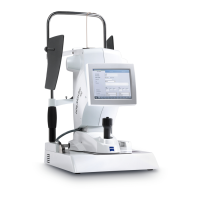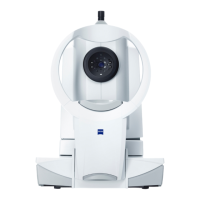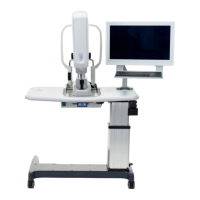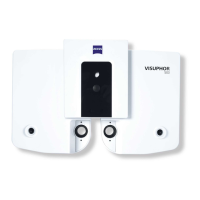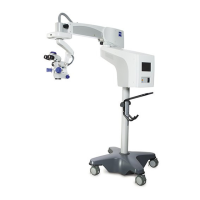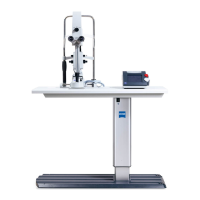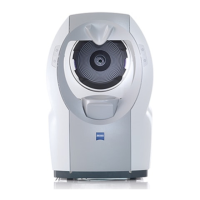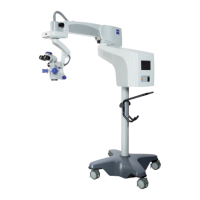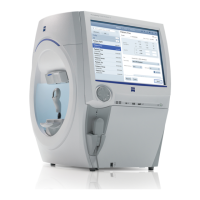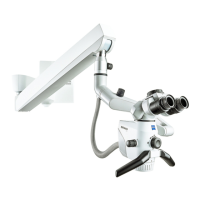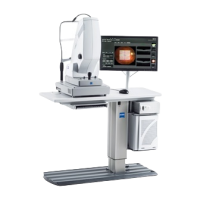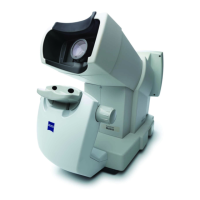Do you have a question about the Zeiss IOLMaster 500 and is the answer not in the manual?
Explains the purpose and accessibility of the user manual for safe and successful operation.
Provides contact information for user questions or comments regarding the manual or device.
Details the product's classification and declarations from the manufacturer.
Describes the intended use of the Option Reference Image accessory with the IOLMaster 500.
Lists contraindications for using the Option Reference Image, specifically regarding nystagmus.
Defines the intended user for the device, restricting sale to physicians or practitioners.
Explains how the Option Reference Image works as an accessory to the IOLMaster 500.
Details the process for updating the IOLMaster software to version 7.7.
Outlines essential safety precautions for patient interaction with the instrument.
Explains how to enable the Automatic Reference Image function and set astigmatism thresholds.
Assesses the quality of reference images based on various factors.
Discusses how stray light affects vessel detection and provides remedies.
Addresses issues with eye centering and its impact on image quality and vessel detection.
Explains how a small palpebral aperture hinders accurate vessel detection near the limbus.
Details how excessive eye movements can compromise reference image quality and lead to inaccurate measurements.
Describes the scenario where insufficient vessels are present for accurate detection, impacting suitability for lens adjustment.
Discusses variations in keratometer readings and their significance for measurements in Reference Image mode.
Details optical radiation and ambient conditions for intended use, storage, and transport.
Explains the purpose and accessibility of the user manual for safe and successful operation.
Provides contact information for user questions or comments regarding the manual or device.
Details the product's classification and declarations from the manufacturer.
Describes the intended use of the Option Reference Image accessory with the IOLMaster 500.
Lists contraindications for using the Option Reference Image, specifically regarding nystagmus.
Defines the intended user for the device, restricting sale to physicians or practitioners.
Explains how the Option Reference Image works as an accessory to the IOLMaster 500.
Details the process for updating the IOLMaster software to version 7.7.
Outlines essential safety precautions for patient interaction with the instrument.
Explains how to enable the Automatic Reference Image function and set astigmatism thresholds.
Assesses the quality of reference images based on various factors.
Discusses how stray light affects vessel detection and provides remedies.
Addresses issues with eye centering and its impact on image quality and vessel detection.
Explains how a small palpebral aperture hinders accurate vessel detection near the limbus.
Details how excessive eye movements can compromise reference image quality and lead to inaccurate measurements.
Describes the scenario where insufficient vessels are present for accurate detection, impacting suitability for lens adjustment.
Discusses variations in keratometer readings and their significance for measurements in Reference Image mode.
Details optical radiation and ambient conditions for intended use, storage, and transport.
| Axial Length Measurement Accuracy | ± 0.02 mm |
|---|---|
| Axial length resolution | 0.01 mm |
| White-to-White Measurement Accuracy | ± 0.1 mm |
| Pupil Diameter Measurement Accuracy | ± 0.1 mm |
| Anterior Chamber Depth Measurement Range | 1.5 – 6.0 mm |
| Pupil Diameter Measurement Range | 2 to 10 mm |
| Measurement Time | Less than 1 second |
| Data Output | USB |
| IOL calculation formulas | SRK/T, Hoffer Q, Holladay 1, Haigis |
| Display | Touchscreen |
| Connectivity | USB, Ethernet |
| Power Requirements | 100-240 V, 50/60 Hz |
